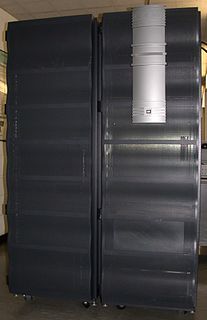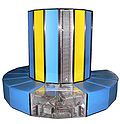Related Research Articles

Seymour Roger Cray was an American electrical engineer and supercomputer architect who designed a series of computers that were the fastest in the world for decades, and founded Cray Research which built many of these machines. Called "the father of supercomputing", Cray has been credited with creating the supercomputer industry. Joel S. Birnbaum, then chief technology officer of Hewlett-Packard, said of him: "It seems impossible to exaggerate the effect he had on the industry; many of the things that high performance computers now do routinely were at the farthest edge of credibility when Seymour envisioned them." Larry Smarr, then director of the National Center for Supercomputing Applications at the University of Illinois said that Cray is "the Thomas Edison of the supercomputing industry."

The Cray-1 was a supercomputer designed, manufactured and marketed by Cray Research. Announced in 1975, the first Cray-1 system was installed at Los Alamos National Laboratory in 1976. Eventually, over 100 Cray-1s were sold, making it one of the most successful supercomputers in history. It is perhaps best known for its unique shape, a relatively small C-shaped cabinet with a ring of benches around the outside covering the power supplies and the cooling system.
Convex Computer Corporation was a company that developed, manufactured and marketed vector minisupercomputers and supercomputers for small-to-medium-sized businesses. Their later Exemplar series of parallel computing machines were based on the Hewlett-Packard (HP) PA-RISC microprocessors, and in 1995, HP bought the company. Exemplar machines were offered for sale by HP for some time, and Exemplar technology was used in HP's V-Class machines.
Cray Inc., a subsidiary of Hewlett Packard Enterprise, is an American supercomputer manufacturer headquartered in Seattle, Washington. It also manufactures systems for data storage and analytics. Several Cray supercomputer systems are listed in the TOP500, which ranks the most powerful supercomputers in the world.

The Cray X-MP was a supercomputer designed, built and sold by Cray Research. It was announced in 1982 as the "cleaned up" successor to the 1975 Cray-1, and was the world's fastest computer from 1983 to 1985 with a quad-processor system performance of 800 MFLOPS. The principal designer was Steve Chen.
The Cray Operating System (COS) succeeded Chippewa Operating System and is Cray Research's now discontinued proprietary operating system for its Cray-1 (1976) and Cray X-MP supercomputers, and those platforms' main OS until replaced by UNICOS in the late 1980s. COS was delivered with Cray Assembly Language (CAL), Cray FORTRAN (CFT), and Pascal.

The Cray Y-MP was a supercomputer sold by Cray Research from 1988, and the successor to the company's X-MP. The Y-MP retained software compatibility with the X-MP, but extended the address registers from 24 to 32 bits. High-density VLSI ECL technology was used and a new liquid cooling system was devised. The Y-MP ran the Cray UNICOS operating system.
Floating Point Systems Inc. (FPS) was a Beaverton, Oregon vendor of attached array processors and minisupercomputers. The company was founded in 1970 by former Tektronix engineer Norm Winningstad, with partners Tom Prince, Frank Bouton and Robert Carter. Carter was a salesman for Data General Corp. who persuaded Bouton and Prince to leave Tektronix to start the new company. Winningstad was the fourth partner.

The Cray-3 was a vector supercomputer, Seymour Cray's designated successor to the Cray-2. The system was one of the first major applications of gallium arsenide (GaAs) semiconductors in computing, using hundreds of custom built ICs packed into a 1 cubic foot (0.028 m3) CPU. The design goal was performance around 16 GFLOPS, about 12 times that of the Cray-2.

The Cray-2 is a supercomputer with four vector processors made by Cray Research starting in 1985. At 1.9 GFLOPS peak performance, it was the fastest machine in the world when it was released, replacing the Cray X-MP in that spot. It was, in turn, replaced in that spot by the Cray Y-MP in 1988.
The Cray Time Sharing System, also known in the Cray user community as CTSS, was developed as an operating system for the Cray-1 or Cray X-MP line of supercomputers. CTSS was developed by the Los Alamos Scientific Laboratory in conjunction with the Lawrence Livermore Laboratory. CTSS was popular with Cray sites in the United States Department of Energy (DOE), but was used by several other Cray sites, such as the San Diego Supercomputing Center.

The SPARCstation, SPARCserver and SPARCcenter product lines are a series of SPARC-based computer workstations and servers in desktop, desk side (pedestal) and rack-based form factor configurations, that were developed and sold by Sun Microsystems.
The Cray C90 series was a vector processor supercomputer launched by Cray Research in 1991. The C90 was a development of the Cray Y-MP architecture. Compared to the Y-MP, the C90 processor had a dual vector pipeline and a faster 4.1 ns clock cycle (244 MHz), which together gave three times the performance of the Y-MP processor. The maximum number of processors in a system was also doubled from eight to 16. The C90 series used the same Model E IOS and UNICOS operating system as the earlier Y-MP Model E.
The Cray T90 series was the last of a line of vector processing supercomputers manufactured by Cray Research, Inc, superseding the Cray C90 series. The first machines were shipped in 1995, and featured a 2.2 ns (450 MHz) clock cycle and two-wide vector pipes, for a peak speed of 1.8 gigaflops per processor; the high clock speed arises from the CPUs being built using ECL logic. As with the Cray J90, each CPU contained a scalar data cache, in addition to the instruction buffering/caching which has always been in Cray architectures.
The Cray SV1 is a vector processor supercomputer from the Cray Research division of Silicon Graphics introduced in 1998. The SV1 has since been succeeded by the Cray X1 and X1E vector supercomputers. Like its predecessor, the Cray J90, the SV1 used CMOS processors, which lowered the cost of the system, and allowed the computer to be air-cooled. The SV1 was backwards compatible with J90 and Y-MP software, and ran the same UNIX-derived UNICOS operating system. The SV1 used Cray floating point representation, not the IEEE 754 floating point format used on the Cray T3E and some Cray T90 systems.

The Cray J90 series was an air-cooled vector processor supercomputer first sold by Cray Research in 1994. The J90 evolved from the Cray Y-MP EL minisupercomputer, and is compatible with Y-MP software, running the same UNICOS operating system. The J90 supported up to 32 CMOS processors with a 10 ns clock. It supported up to 4 GB of main memory and up to 48 GB/s of memory bandwidth, giving it considerably less performance than the contemporary Cray T90, but making it a strong competitor to other technical computers in its price range. All input/output in a J90 system was handled by an IOS called IOS Model V. The IOS-V was based on the VME64 bus and SPARC I/O processors (IOPs) running the VxWorks RTOS. The IOS was programmed to emulate the IOS Model E, used in the larger Cray Y-MP systems, in order to minimize changes in the UNICOS operating system. By using standard VME boards, a wide variety of commodity peripherals could be used.
DGSCA, a.k.a. Computo Academico UNAM, previously known as PUC. It is the leading organization within the UNAM for computer technologies systems and held the distinction for being the first institution in México to install and operate a Cray Y-MP super computer, in early 1990.
Supertek Computers Inc. was a computer company founded in Santa Clara, California in 1985 by Mike Fung, an ex-Hewlett-Packard project manager, with the aim of designing and selling low-cost minisupercomputers compatible with those from Cray Research.
The Cray S-MP was a multiprocessor server computer sold by Cray Research from 1992 to 1993. It was based on the Sun SPARC microprocessor architecture and could be configured with up to eight 66 MHz BIT B5000 processors. Optionally, a Cray APP matrix co-processor cluster could be added to an S-MP system.

The main credit to supercomputers goes to the inventor of CDC -6600, Seymour Cray. The history of supercomputing goes back to the early 1920s in the United States with the IBM tabulators at Columbia University and a series of computers at Control Data Corporation (CDC), designed by Seymour Cray to use innovative designs and parallelism to achieve superior computational peak performance. The CDC 6600, released in 1964, is generally considered the first supercomputer. However, some earlier computers were considered supercomputers for their day, such as the 1954 IBM NORC, the 1960 UNIVAC LARC, and the IBM 7030 Stretch and the Atlas, both in 1962.
References
- Fred Gannett's Cray FAQ
- Chippewa Falls Museum of Industry & Technology: Cray Computer Systems
- Cray in Deal To Acquire Supertek, New York Times
| This supercomputer-related article is a stub. You can help Wikipedia by expanding it. |
